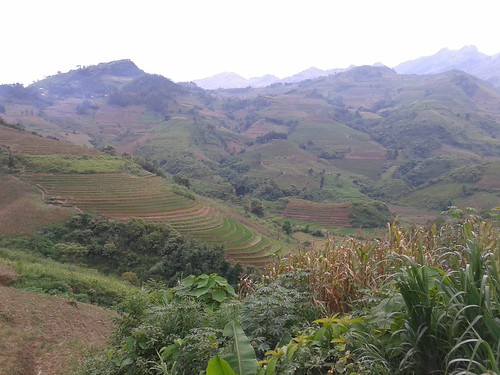The recent situational analysis undertaken by the Humidtropics CGIAR research program in Northwest Vietnam identified three main value chains to bring agricultural products to markets:
- Direct marketing chains from farmers to consumers where farmers go to the retail market to sell their produce.
- Chains with ‘intermediaries’ linking producers through rural collectors to city wholesalers and processing agents. These are the dominant chains bringing produce from remote mountainous areas to city markets.
- Value chains targeting regional export markets for maize, fruits, tea and coffee.
The main recommendation from the situational analysis is to use existing success stories of marketing business models to replicate those within value chains for indigenous local foods targeting niche markets.
So this week my colleague Aziz Karimov, from the International Livestock Research Institute (ILRI) Office in Hanoi, and I partnered with the Agriculture Economics and Value Chains Department of the Centre for Agrarian Systems Research and Development (CASRAD) to conduct a value chain assessment on four agricultural products in Son La Province of Vietnam: maize, pigs, plums and tea.
The Humidtropics value chain assessment is based on the LINK methodology developed by the Center for International Tropical Agriculture (CIAT). It is applied during a two-day workshop with various stakeholders from the value chains, and government and development partners. The first part of the workshop maps the value chains of interest. On the second day, participants identify interesting business models for linking smallholder farmers to dynamic markets. Each value chain actor reflects on what their customers may want and what they offer to their suppliers. This helps agribusiness researchers identify which business models work in a given location and for which products. We can then try to adapt and replicate them in another commodity chain or location.
As an example, consider maize collectors in Son La Province. They are often decried as ‘evil middlemen’. But the group working on maize in the workshop, which included two farmers, one collector and the CASRAD facilitator, identified their clear value proposition to both smallholder suppliers and animal feed miller customers: they provide a very convenient service. They make sure that the maize they sell to the millers meets quality standards; their extensive network of maize producers allows them to respond immediately to demands of millers to feed the booming livestock industry in Vietnam. The convenience of the collectors’ service for the ethnic minority smallholder producers farming high up in the remote mountains of Son La Province is even more interesting: They pay for the harvest in cash upon collection from the farm plot; they send and pay for the transport of the grain down from the mountains; they provide a good price for the grain; they usually help producers by investing in farm services and inputs against a commitment from the farmers to sell the maize back to them; finally, they also provide gifts in kind to their suppliers who do not have to worry about finding a market outlet for their maize, even in the full glut season.
Similar discussions on the other plum, pig and tea value chains provided further insights into business models linking smallholder farmers to dynamic markets. These are helping us suggest future Humidtropics research-for-development interventions on policies, institutions and markets.
Jo Cadilhon, ILRI Policy, Trade and Value Chain Program
Read a longer version of this story

